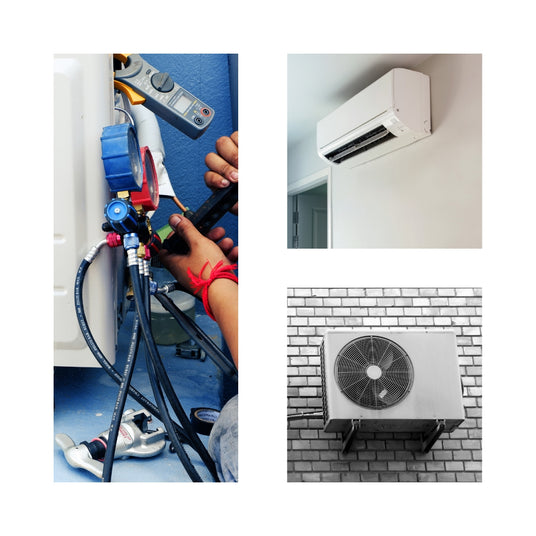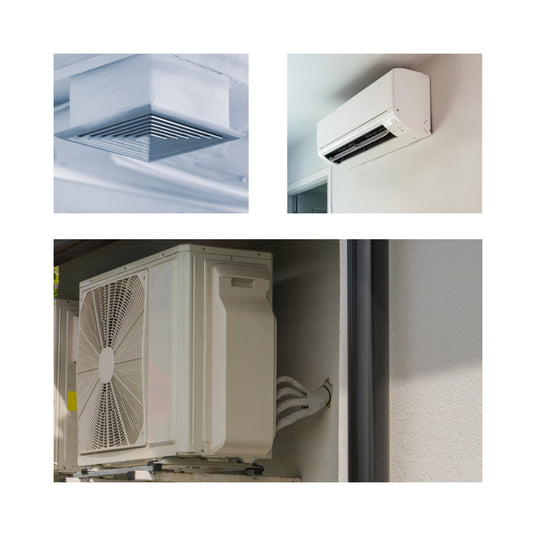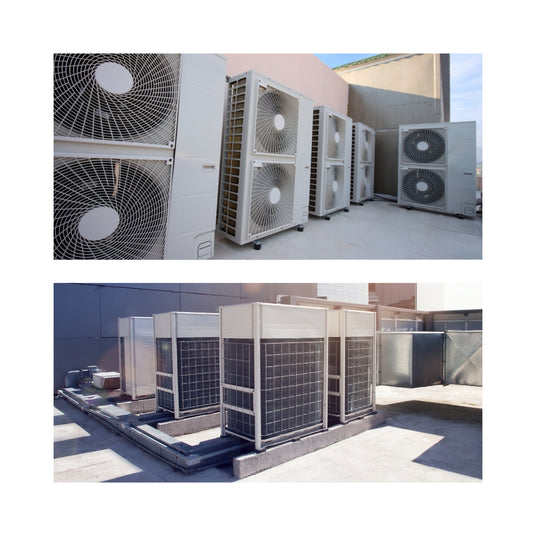Single Split, Multi-Split or Commercial System?
Whichever product you choose, it will require professional installation. Below you can find details regarding the installation process.

Single Split Air Conditioning
One individual indoor unit (evaporator) connected and powered by one individual outdoor (condensor) unit.
Install Details
Can I install the unit myself?
Can I install the unit myself?
No. All single split air conditioning systems must be installed by an F-GAS registered installer.
The installation process of all split type air conditoning systems is a complicated process, requiring industry specific tools and knowledge. The system should be pressure tested to a high pressure (usually somewhere around 40-42 BAR) and also includes performing a vacuum of the system to remove any and all moisture from within the pipes.
If this is not done correctly, not only is the system likely to malfunction but it may be possible to leak refrigerant into the atmosphere, which is an illegal offence.
Water (Condensate) Drainage
Does the unit require water to be drained away manually?
Does the unit require water to be drained away manually?
There is no need to manually drain away any water from a professionally installed single split system.
During the installation process, the engineer will connect a condensate drain pipe to remove water from the internal evaporator. This will be done either naturally using gravity or pumped away using a condensate pump (if required).
Does the unit require a connection to a water supply for input or drainage?
Does the unit require a connection to a water supply for input or drainage?
Unless you have selected a vary rare or bespoke system, there is no need to connect a standard single split air conditioning system to a water source for input or drainage.
Pipes
What type of pipework is required?
What type of pipework is required?
During the installation, the engineer will connect the indoor (evaporator) unit to the outdoor (condensor) unit via two refrigerant pipes. This is required so the contained refrigerant can complete the evaporation cycle effectively, in order to provide the desired coolign and heating functions from the system.
The pipework is usually made from copper and covered in a high density foam lagging to provide insulation. This pipework is often attached to the outside of the building, but if you would prefer not to see the pipework on show, you could always opt for trunking to cover the pipes, which is often more aesthetically pleasing.
Electrics
What kind of power supply is required?
What kind of power supply is required?
Depending on the size of the system that is to be installed, it may be possible to branch off from an existing power supply within the property. However, if the system requires a higher amperage supply, you may have to have a designated electrical circuit installed too.
The power supply often runs to a rotary isolator, which is usually installed within 1 metre of the outdoor (condensor) unit for safety reasons.
You may need to employ the services of a qualified electrician to carry out any electrical work required.
We can provide a data sheet for all of the systems we supply, which will have all the relevant information attaining the power supply requirements of your chosen system.

Multi Split Air Conditioning
When exterior space is at a premium and you desire more than one internal unit to be installed, multi-split systems may be the best option.
With the ability to operate up to 5 indoor units (of different types and size) from just one external unit, multi split systems can offer great flexibility when desgining your climate control solution.
Install Details
Can I install the unit myself?
Can I install the unit myself?
No. All multi split air conditioning systems must be installed by an F-GAS registered engineer.
The installation process of all split type air conditoning systems is a complicated process, requiring industry specific tools and knowledge. The system should be pressure tested to a high pressure (usually somewhere around 40-42 BAR) and also includes performing a vacuum of the system to remove any and all moisture from within the pipes.
If this is not done correctly, not only is the system likely to malfunction but it may be possible to leak refrigerant into the atmosphere, which is an illegal offence.
Water (Condensate) Drainage
Does the unit require water to be drained away manually?
Does the unit require water to be drained away manually?
No. A correctly installed multi split air conditioning system will have a condensate drain hose connected to the rear of every indoor unit, to remove unwanted water generated during cooling mode.
Condensate is often removed by using gravity, but can also be aided by using a condensate pump (which may be built in to certain styles of indoor units).
If the system is installed correctly, there should be no chance of water leaking into the property from any of the indoor units.
Does the unit require a water connection?
Does the unit require a water connection?
No. There is no need to connect a multi split system to a water source for the input of extract of water.
The condensate that will be generated from the the unit while performing certain modes of function, will be drained away using hoses or pipework which are fitted during the units installation process.
Pipes
What type of pipework is required?
What type of pipework is required?
The pipework is usually made from copper and covered in a high density foam lagging to provide insulation. This pipework is often attached to the outside of the building, but if you would prefer not to see the pipework on show, you could always opt for trunking to cover the pipes, which is often more aesthetically pleasing.
In order to operate correctly, each indoor unit that is desired to be connected to the multi split air conditioning system must have 2 seperate pipes attached. If you choose to have a multi split system operating a total of 5 indoor units, this means you will have a total of 10 different pipes connecting to the outdoor unit.
The pipework is essential to the operation of the system, as it carries the required refrigerant through the system in order to carryout the fucntion of the evaporation cycle.
Electrics
What kind of power supply is required?
What kind of power supply is required?
Depending on the size of the multi split system that is to be installed, it may be possible to branch off from an existing power supply within the property. However, this is likely only suiteable for small systems with only 1 or 2 indoor units connected.
Choosing a system which requires a higher amperage supply, means you may have to have a designated electrical circuit installed too.
The power supply often runs to a rotary isolator, which is usually installed within 1 metre of the outdoor (condensor) unit for safety reasons.
You may need to employ the services of a qualified electrician to carry out any electrical work required.
We can provide a data sheet for all of the systems we supply, which will have all the relevant information attaining the power supply requirements of your chosen system.

Commercial Air Conditioning
Commercial properties require very specific systems to be installed. These large systems must to be capable of operating numerous internal units, in different modes of operation simultaneously.
Usually referred to as VRF or VRF systems, they must be designed using lots of technical information and measurements on a case by case basis.
If you are interested in discussing a bespoke system for your commerical requirements, please get in contact using the button below


